 When we say Quiapo, the first things that come to mind are images of the Black Nazarene, the multitude of people that makes an annual walk of fate with the image during the 9th of January processions, and the Basilica Minore of the Black Nazarene (Quiapo Church) with the myriad of hawkers and stalls, herbal medicine and anting-anting vendors and fortune tellers abundant in adjacent Plaza Miranda. But unknown to many, Quiapo is home to an even rarer gem, another basilica minore in fact in Plaza del Carmen. This is the Basilica Minore de San Sebastian, the first all-steel church in the Philippines and in Asia, and the second in the world.
When we say Quiapo, the first things that come to mind are images of the Black Nazarene, the multitude of people that makes an annual walk of fate with the image during the 9th of January processions, and the Basilica Minore of the Black Nazarene (Quiapo Church) with the myriad of hawkers and stalls, herbal medicine and anting-anting vendors and fortune tellers abundant in adjacent Plaza Miranda. But unknown to many, Quiapo is home to an even rarer gem, another basilica minore in fact in Plaza del Carmen. This is the Basilica Minore de San Sebastian, the first all-steel church in the Philippines and in Asia, and the second in the world.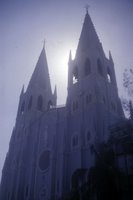
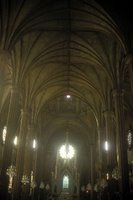 I was looking through my archive of photos which I took long before I started to blog. In fact, several were taken even before I enjoyed internet access. And among them were photos of the San Sebastian Church which I shot way back in high school during an alternative class day exposure trip to old Manila. I realized that my photo archive was a wealth of untapped material and not featuring these places I've been to and documented would be a waste.
I was looking through my archive of photos which I took long before I started to blog. In fact, several were taken even before I enjoyed internet access. And among them were photos of the San Sebastian Church which I shot way back in high school during an alternative class day exposure trip to old Manila. I realized that my photo archive was a wealth of untapped material and not featuring these places I've been to and documented would be a waste.It was sometime in 1995 or 1996, my third year in the Ateneo and we were the beneficiaries of the first-ever alternative class day called KLIK... Klaseng Ibang Klase. We had a choice of selecting three talks throughout the day or pick a day trip for a fee. And I chose this trip to old Manila, with social studies teacher Estela Banasihan and Fr. Mac Reyes, S.J. as tour guides. I consider this trip my introduction to Philippine architectural heritage. The trip tickled my fancy in fact that the next year, I chose another heritage tour during KLIK, a church tour in Rizal and Laguna.
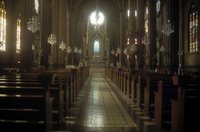 One of our stops was the San Sebastian Church. And to tell you honestly, I was not ready for what I was going to see. Upon entering, this young high school student never realized that such a treasure existed in the country. And I remember distinctly Fr. Mac knocking on the walls of the church to prove to us that the structure was indeed made of steel!
One of our stops was the San Sebastian Church. And to tell you honestly, I was not ready for what I was going to see. Upon entering, this young high school student never realized that such a treasure existed in the country. And I remember distinctly Fr. Mac knocking on the walls of the church to prove to us that the structure was indeed made of steel!I would later find out that the Philippines used to have much more than that. But the very structures which made us the Pearl of the Orient, architectural treasures that spanned hundreds of years, were flattened by the American Army in a few days during the liberation of Manila.
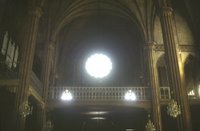 The structure was prefabricated in Belgium, dismantled and shipped back to the Philippines. It was said that after three earthquakes that leveled the earlier San Sebastian churches, the Recollects decided to use an unconventional material to build an earthquake proof church. Which explains why the structure is entirely made of steel. But nothing is decay-free and we all know that the biggest enemy of steel is iron oxide, more commonly known as rust!
The structure was prefabricated in Belgium, dismantled and shipped back to the Philippines. It was said that after three earthquakes that leveled the earlier San Sebastian churches, the Recollects decided to use an unconventional material to build an earthquake proof church. Which explains why the structure is entirely made of steel. But nothing is decay-free and we all know that the biggest enemy of steel is iron oxide, more commonly known as rust!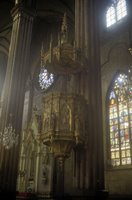
 This is why the World Monuments Fund (WMF) included the structure in the List of 100 Most Endangered Sites in 1998. Inclusion in the World Monuments Watch entitles the structure to grants for restoration. And I find it stupid that the custodians of the church rejected the $25,000 grant given by the WMF simply because of jurisdiction issues with the Philippine government. As a result, the Philippines had to do the embarrassing act of returning the $25,000 to the WMF!
This is why the World Monuments Fund (WMF) included the structure in the List of 100 Most Endangered Sites in 1998. Inclusion in the World Monuments Watch entitles the structure to grants for restoration. And I find it stupid that the custodians of the church rejected the $25,000 grant given by the WMF simply because of jurisdiction issues with the Philippine government. As a result, the Philippines had to do the embarrassing act of returning the $25,000 to the WMF!It reminds me of the lack of appreciation for heritage rampant in the Catholic Church. In fact, priests are the number one destroyers of Philippine church heritage. They sell off antiques to raise money, lured by heavenly sums offered by sneaky antique collectors. A big number renovate their heritage churches according to their whims and caprices simply to leave their mark, damaging or even eradicating centuries of work in a few months. Right at this very moment, the hard-headed parish priest in Paoay, a UNESCO World Heritage site, is plastering the walls of the church with cement! When will this carnage to heritage churches end? Will the CBCP please put its foot down and end this wanton disregard for Philippine architectural heritage. In Mexico, after their own revolution against Spain, all church property became state property which is why all their churches are untouched and well-preserved. Sometimes, I wished that happened in the Philippines as well.
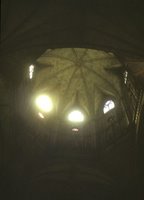 Back to San Sebastian, rumor has it that the metal structure of the San Sebastian Church was designed by Alexander Gustave Eiffel himself. But I have yet to hear the official word from the NHI or NCCA.
Back to San Sebastian, rumor has it that the metal structure of the San Sebastian Church was designed by Alexander Gustave Eiffel himself. But I have yet to hear the official word from the NHI or NCCA.Metro Manila is host to more heritage churches or what's left of them. You can check out the Visita Iglesia Manila Project for a complete listing.

No comments:
Post a Comment